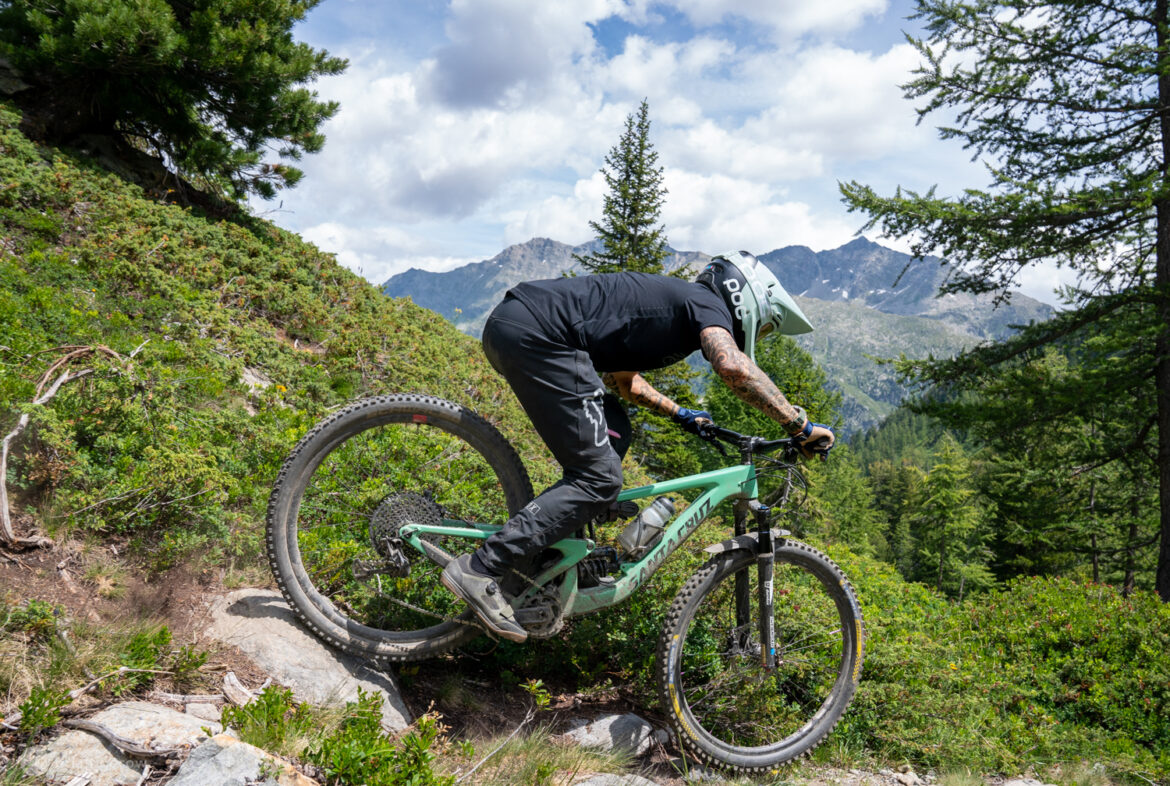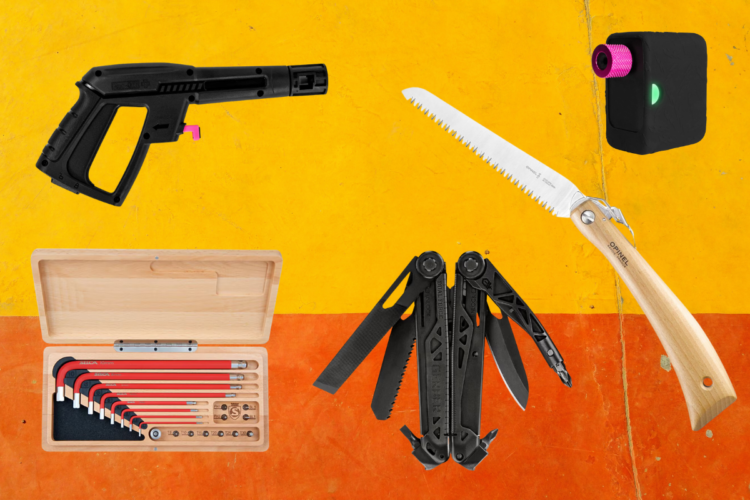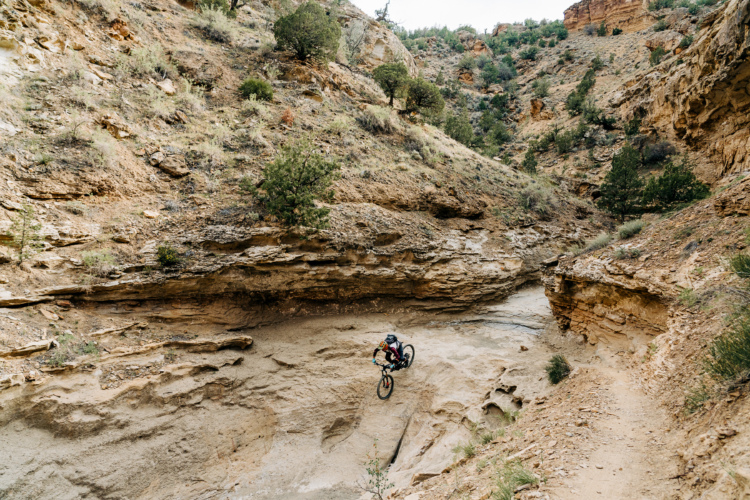
All review bikes receive a proper test, and this one in particular collected some extra stone scars to prove its place under the “enduro” umbrella. After a couple of weeks spent riding lunch laps at home, I brought the Santa Cruz Megatower along on vacation to my personal favorite trails in La Thuile, Italy. There, it endured an additional two weeks of steep daylong adventures. While many of the trails I have ridden in Europe are steeper and rougher than those I found in the US, the tracks in La Thuile are some of the most challenging I have seen anywhere. The lesser known descents in Nelson, BC, offer a good comparison, though they’re a bit shorter if I recall correctly.
Lead trail builder for the La Thuile Bike Park, Enrico Martello, says that when the Enduro World Series asked him to build new trails for the race he did so with Sam Hill alone in mind. When you’re riding them there’s no question that these descents were cut to test legends, and for us amateur riders they provide countless opportunities to learn and improve. I have yet to see or ride anything steeper and more demanding, and we’ll have a full rundown of the fun in La Thuile soon.
Now, on to the carbon wonder bike. The Megatower is a 160/160mm bike with 29″ wheels, that was designed, like Martello’s trails, for elite level enduro racing. Santa Cruz says it will ride fine with up to a 180mm fork if that fits with your needs. The frame has a pair of flip chips that allow its owner to adjust the BB height, headtube angle, seat tube angle, and chainstay length to suit their trails and riding style. Its robust gravity builds range in price from $4,499 for the base build (available online at Competitive Cyclist), up to a wireless electric build with Reserve carbon rims for $10,499. The bike I tested had the second tier component spec, with a coil shock and carbon rim upgrades, all going for a cool $6,599. The CC frameset is available with a RockShox Deluxe Ultimate air or coil shock for $3,299 (both are available from Competitive Cyclist).
Athletes from around the globe have piloted this capable platform to the top steps of prestigious enduro podiums, and I was childishly excited to throw it down some of my favorite lines. Here’s the scoop.
The C carbon frame

Bike reviews would be more appropriately titled “bike frame review,” since it’s the geometry, suspension design, and unique frame elements that we’re most immediately concerned with. The few times I have purchased a complete bike I have rarely kept half of the components that the company mounted up, making the build spec a less crucial characteristic. That stated I will critique all of the elements that Santa Cruz chose for this frame and build, to determine if it’s worth the asking price.
The Megatower frame’s angles are in line with many of the race-leading bikes at the start line. The size medium that I’ve been sliding around on has a somewhat shorter 447mm reach in the low position, balanced by 436mm chainstays that can be adjusted to a more stabilizing 446mm measurement. With an appropriately slack 64.7° headtube and 76.4° seat tube angle, the engineers at Santa Cruz definitely remembered that this bike needs to be rocketed downhill and efficiently pedaled back up for more.
Despite my medium stature of 5’8″-ish (173cm) and 30″ (76cm) inseam, the short seat tubes across the Megatower size run would allow me to ride a size up from the medium that I tested. If this were my personal bike, I would definitely order a size large for its 2cm of additional reach. A bike this capable would only become more so with a little more length.
The rear triangle and downtube are appropriately protected from chain slaps and rock strikes, however, if I paid retail for this frame it would definitely get wrapped in a frame protection kit. That minty paint is too pretty to wipe off along the trail. The bike I rode had been tested by several other journalists prior, and each of their mistakes glowed just as brightly as mine.
All of the little details, like routing the rear brake hose so that it can’t touch the spokes, are accounted for on the Megatower. One element that could be a little frustrating is that the shock’s rebound knob is nested under the tiny rear fender and it can be tricky to access. Fortunately that’s not an adjustment most riders will fiddle with on every ride.

The carbon fiber rear triangle has plenty of space for wide 29 x 2.5″ tires and leftover mud clearance, and the tiny fender does a good job of keeping the low slung shock clear of larger trail debris.
All but two of the latest Santa Cruz mountain bike models use their VPP lower link suspension design, and for good reason. While I will dig into the ride sensations shortly, I can say that this platform has some unique qualities that set it apart from the competition. It feels as supportive on technical climbs as it does loose descents, the platform doesn’t require fancy shock tunes and works with coil or air-sprung shocks, and it has an overall feeling of durability — in just the way you want a suspension platform to feel on a bike that’s designed to hit thousands of square edges and bounce back for more.

The S build, with coil shock and carbon rim upgrades

So what components did Santa Cruz Bicycles decide an enduro race bike at this price range should be built up with? Some of those in the photo above were included in the build, though this bike did see a load of fun setup swaps.
I’ll start where most bike companies skimp, with the brakes and tires. All of the Megatower builds come shod in a set of 29 x 2.5″ Maxxis Assegai tubeless tires with the mid-level EXO+ casing. While I would love to see a DH casing around the rear wheel, this is a tougher set of rubber than I have seen on any other enduro bike I’ve reviewed. My test bike came with a replacement set of DHF/DHR II tread with EXO+ casings, and I managed to puncture both tires a few times before replacing them with a heavier gravity set.

The SRAM Code R 4-piston brake spec seems like a reasonable one for most trails, like the EXO+ tire casings, but they were laughably underpowered for the trails in La Thuile. I have been challenging myself this season to consistently think about braking while riding, and to not feather or use the brakes when I don’t need to. Less brake dragging should equate to higher overall speeds, less hand fatigue, and cooler brakes that work better when I need them.
With these Code R brakes that braking method simply wasn’t possible on the longer 20+ minute runs. Even with dual 200mm rotors they don’t have the truck-stopping power that I’m used getting from other models, and I had to use them a lot more than I wanted to. I wasn’t racing, so the resulting slower times meant nothing, but the forearm and hand pain had me wanting to swap them out halfway down every run. I went through three sets of pads on this bike, with only one truly rain soaked ride, which speaks to just how steep the trails are in La Thuile and how much I had to death-clamp the underpowered levers.
Were this my personal bike, I would upgrade the brakes to a set of SRAM Code RSC stoppers, Formula Cura 4, or the Shimano XTR 9120. If I lived in La Thuile, I would skip straight to a pair of Saints and forget about hand pain all together.

My test bike rolled on a set of Santa Cruz Reserve carbon rims, laced to DT Swiss 370 hubs. I’m fairly certain that I’ve never slapped a carbon rim into as many rocks as I did this one, and it remains true and sound. I checked for cracks while replacing the thrice punctured rear tire, but there were no visible signs of my handiwork. The deep rims give the bike a precise feel that’s worth the extra cost if you can swing it. I’ll definitely be coming to La Thuile to test carbon hoops from now on. It’s like a lab, but fun!
The coil vs. air damper question is one of personal preference, and for my liking, the RockShox Super Deluxe Coil Select+ made the Megatower mega. The added grip and overall tunability of this coil-sprung shock, coupled with the progressive ramp of the VPP suspension, equals an impressively enduro-ready bike overall. With both the stock Fox Performance 36 fork and the SR Suntour Durolux 36 that I got to test on this bike the coil provided the right balance of grip and pop for the rear half. If Santa Cruz offered the RockShox Super Deluxe Coil Ultimate model, with its adjustable compression circuit, that would be even better. As it is, this little springer works quite well.
The remaining bits of this build are largely unmentionable, because they simply worked well and are appropriately selected for the bike’s intentions. The Reverb dropper went up and down as asked, though it has significantly slowed down and it’s due for a rebuild. The MRP chainguide and guard saved the 30-tooth chainring from taco status multiple times, and the SRAM GX Eagle shifter and derailleur swapped all 12 gears just fine — between my multiple derailleur hanger realignment sessions.
On the slightly less favorable (yet totally tolerable) side, the Race Face 780mm alloy handlebar and 40mm stem proved a little harsh for my liking. This was particularly evident after riding the OneUp carbon bar for a season. Also, the stock WTB Silverado Pro saddle was swapped out after one ride for a platform that better fits my butt.

The ride

Unfortunately, the image stabilization in my action camera is kaput, and none of my video footage of the Megatower nor these beautiful mountains is watchable. If you want a peek at the trails and scenery, check out this video of highlights from the 2016 EWS race in La Thuile.
So, let’s get this thing to the top of some trails. I climbed the hills behind my apartment for a number of weeks before taking the Megatower to La Thuile for chairlift laps, and the bike put an ascent smile on my face. Similarly to the Yeti SB150, you can climb on this bike with the shock’s compression switch flipped all the way open. There’s no notable pedal bob, and the rear tire maintains traction without eating up all the calories you inhaled at breakfast. The platform feels super supportive, and at my weight of 68kg (150lbs) the difference between climbing with the compression circuit open or closed is minimal. For reference, the shock comes with a 450lb spring on the size medium, which was plenty supportive for my weight.
We rode all of the trails from the EWS races that have taken place in La Thuile, and of course, those include some awkward mid descent sprints and climbs. This is where the supportive suspension platform and stiff carbon frame show their worth. With a clamped windpipe and blurry vision on rippin’ fast descents, having a solid bike to push some leg power into is key. The way the suspension ramps up through the stroke allows it to offer up just the right amount of support for the short and sometimes technical climbs that we often see on enduro race courses. I didn’t notice precisely where or when things started to firm up in the travel, but the bike maintained grip on some off camber roots while I was pedaling whilst I was expecting to slide out at any second.
When the earth starts pulling you down, mixed with a shovel full of traction and balance, the Megatower finds its home. Throwing this bike into near-vertical rock gardens and over roots that I hadn’t yet seen the other side of was a pleasure. Over heinously rough sections of trail, where the tires rarely touch dirt, the 450lb spring does feel a little over-sprung for my weight. Though it wasn’t kicking back or throwing me toward the fork, it did feel a little harsh once the shock was over half-way through its travel. I managed to bottom out the shock a number of times, but to my surprise, there was little to no jarring sensation to follow the audible clang. The bottom outs always happened when I would expect them to, after flying off something and not knowing how far away the landing was. I definitely don’t think the bike needs a stiffer spring for my weight. More like I should take a better look at things.

The flipside of that extra shock resistance is that the bike pops back with a force when you ask nicely. If you hit a compression, or make one, and you want the bike to follow you off the ground, it will comply. With the appropriate rider input, the Megatower will pop and play on trail features like some smaller 29″ trail bikes. That playfulness isn’t for free. This bike seems more planted than bouncy, and it took me a ride or two to determine how much I needed to push down in order to achieve loft. With that sorted out I was largely able to put it where I wanted without much thought or hesitation.
The frame is long enough to feel composed without creating any metro-bus sensations in tight turns. Like any leggy 29er, you do occasionally have to either pivot on the nose or skid the rear wheel on switchbacks, and the stiff frame helps get the rear end whipped around where you need it. I wasn’t able to test the lengthened chainstay setting, as I didn’t have the proper hanger, but I can imagine that a little added leverage out back would only enhance the planted sensations that the bike already exhibits. The longer chainstay would also add leverage on the shock, likely giving the bike a more supple stroke and negating the slightly oversprung sensations that I mentioned. I could see putting the bike in “long” mode for races, when traction and stability matter most, and “short” mode for playing around and jumping.
I flipped the hi/low flip-chip into the “high” setting for a lap, but on the trails I rode it didn’t make sense. The BB isn’t too low with a 29mm drop, and the slack headtube angle is better to stay that way. That stated, this headtube angle is rather slack, and if I regularly rode less steep stuff I would be happy that the engineers thought of me. This bike represents one instance where I feel the geometry adjustment options are warranted.

In conclusion
With few necessary upgrades and complaints, the Megatower is a fantastic bike for folks who race enduro or ride enduro race trails. The adjustable geometry should help it fit a wider variety of trails than some long travel 29ers, and the short seat tubes will allow buyers to choose their ideal reach — to a point. The final change I would ask for with this frame is to have an affordable aluminum option. Given its slam-dance downhill use cases, I would be pretty keen to purchase a full metal version of this bike. As it is, with free lifetime pivot bearing replacement, Megatower owners will likely be keeping this bike in the quiver for quite some time.
⭐️ Find the Santa Cruz Megatower at Competitive Cylist and evo.
We would like to thank Focus Italia Spa. for sending over the Megatower to test and review.






















0 Comments